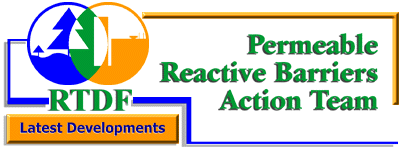 |
|
||||||
|
|
|
||||||
|
|
|||||||
 |
|
||||||
|
|
|
||||||
|
|
|||||||
|
Installation Date: Contaminants: Reactive Media: Cost: Construction: Point of Contact: |
|
|
Two continuous walls have been installed for full-scale cleanup of ground water at the Watervliet Arsenal, the oldest cannon manufacturing facility in the United States. Years of land disposal of wastes from the manufacturing of cannons and the operation of a burn pit contaminated ground water with up to 4,700 μg/L of volatile organic compounds (VOCs). The site is underlain by a layer of fill extending 10 ft to 12 ft below ground surface (bgs) and consisting of mixed sands, clay, rubble, and wood. The hydraulic conductivity of this layer is approximately 8.9 ft/day, and the hydraulic gradient is 0.16 ft/ft. Underlying the fill is a tight (hydraulic conductivity of 0.45 ft/day) layer of lacustrine silt, clay, and peat atop weathered bedrock. The water table is situated within the fill at 2 ft to 5 ft bgs. The seasonal fluctuation of the water table is 2 ft to 3 ft. Two 3-ft-wide and 8-to-12-ft-deep continuous walls were constructed with the goal of reducing levels of chlorinated VOCs to non-detect immediately downgradient of the walls. The southern wall, constructed perpendicular to ground-water flow, is 180 ft long; the northern wall, located further downgradient, is 90 ft long. The walls were constructed using a conventional track-mounted excavator, and the trenches held open with shoring plates with “speed shores.” A mixture of granular iron and concrete sand were placed manually from transit trucks using chutes. The total amount of reactive materials used was 165 tons of iron and 163 tons of sand. One advantage of the constructing the treatment walls rather than a pump-and-treatment system is that the remediation area can be used largely without restriction since there are no plumbing systems or treatment plants to interfere with traffic or storage at the site. However, the presence of the walls may limit other remedial measures and construction. For example, a pump-and-treat system could not be installed in the deeper bedrock aquifer to address possible contamination near the wall. Any dewatering of the surficial aquifer would defeat the operation of the walls.
Thus far in this project, constructing the continuous walls has shown that ground-water modeling can be a powerful tool for design. Studies showed that flow barriers (funnels) would have created underflow and reduced wall efficiency. Also, modeling showed that walls not constructed perpendicular to ground-water flow could have created “piping,” which causes underflow or mounding. This would change the hydrodynamics of the system and could affect the residence time of ground water in the walls. It was difficult to estimate the amount of water that would enter a trench during installation. The estimate, made by excavating a test pit, resulted in the selection of a holding tank that was many orders of magnitude too large. |
![]()
Sponsored by the Technology Innovation Program
Date Last Modified: May 31, 2001